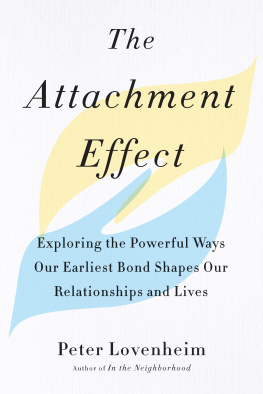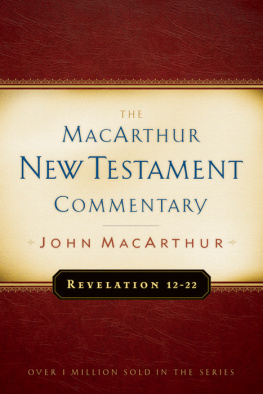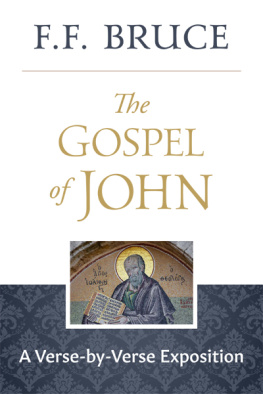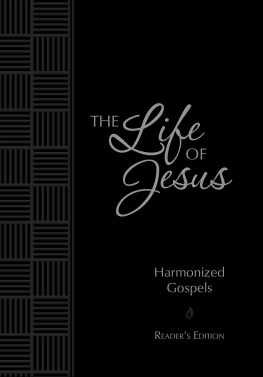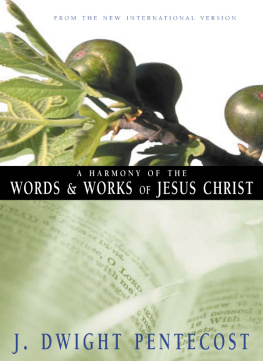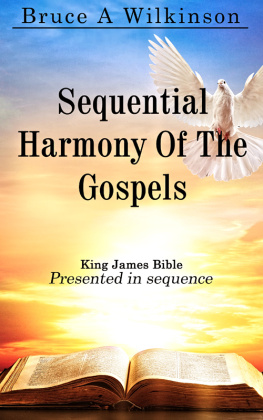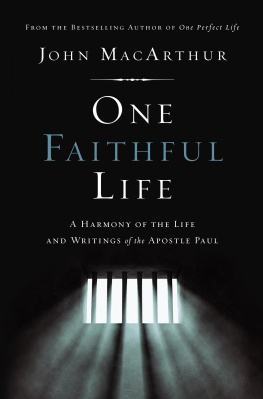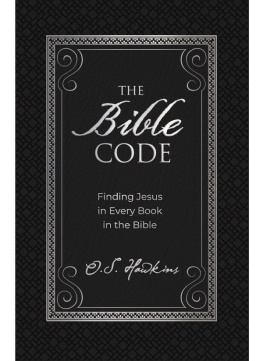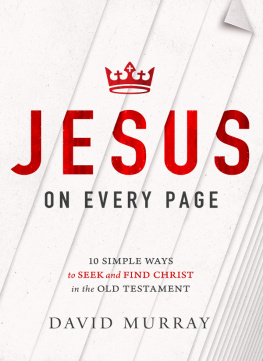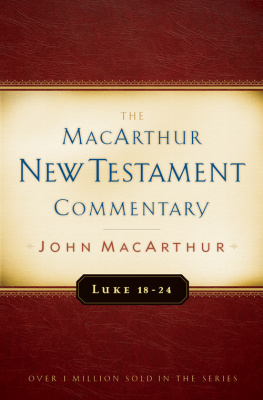One Perfect Life:
The Complete Story of the Lord Jesus
John MacArthur
2012 by John MacArthur
All rights reserved. No portion of this book may be reproduced, stored in a retrieval system, or transmitted in any form or by any meanselectronic, mechanical, photocopy, recording, scanning, or otherexcept for brief quotations in critical reviews or articles, without the prior written permission of the publisher.
Special thanks to Nathan Busenitz and also to the team at Thomas Nelson for their help in the completion of this project.
Published in Nashville, Tennessee, by Thomas Nelson. Thomas Nelson is a registered trademark of Thomas Nelson, Inc.
Unleashing Gods Truth One Verse at a Time is a trademark of Grace to You. all rights reserved.
Thomas Nelson, Inc., titles may be purchased in bulk for educational, business, fund-raising, or sales promotional use. For information, please e-mail .
Unless otherwise noted Scripture quotations are from THE NEW KING JAMES VERSION. 1982 by Thomas Nelson, Inc. Used by permission. All rights reserved.
Library of Congress Cataloging-in-Publication Data
Thank you for purchasing the eBook version of Thomas Nelsons One Perfect Life. Dr. John MacArthur shares with us the complete story of the Eternal Christ from Genesis to Revelation. Using Matthew as the base text, Dr. MacArthur blends the gospels and other biblical material about Jesus into one continuous story that will help you better understand Scripture and grow stronger in your faith. No other harmony of the Gospels includes such extensive study notes to help you unpack the meaning of each verse. As a bonus, we have included the entire New King James Version Bible text as an appendix.
What is the difference between an eBook and a print book?
eBook versions of Nelson Books contain all of the content and supplementary materials found in the original print versions and are optimized for navigation in the various apps and devices used for display. eReaders recognize text as one fluid string and are formatted in a single-column. eReaders currently do not support the more complex layout seen in print version books. Therefore, some content may not appear in the same place as in the original print version, but it is structured consistently.
How do I use the eBook Table of Contents?
*Important Note: Be sure to consult your device manufacturers Users Guide for device-specific navigation instructions.*
The Table of Contents is the primary navigation anchor to quickly access various parts of the book and is generally formatted in the same order as the original print version and hyperlinked as follows:
Front matterIntroductory articles
Main Book TextDivided into individual chapters
Back matterSupplementary materials
Hyperlinks in the Table of Contents quickly access individual chapters as follows:
Chapter links go directly to the beginning of the chapter.
Every chapter hyperlink returns or goes back to the Table of Contents.
Use the devices back button or function to go back to the last selection.
How do I navigate to Bible Books, Chapters and Verses?
Use one of the two methods below to navigate to Bible verses.
Method 1
Navigate to and click a specific chapter hyperlink from the Table of Contents.
Book/Chapter/Verse hyperlinks located under each chapter heading link to the New King James Version Bible.
Following the last Bible verse number listed, example Genesis 1:1, there is a reciprocal link marked Return to One Perfect Life, Chapter ### that will return you to the main book text.
Method 2
Click the New King James Version Appendix hyperlink in the Table of Contents.
Use the devices Next Page/Previous Page buttons or functions to scroll through the Bible books.
Click a chapter number hyperlink.
Use the devices Next Page/Previous Page buttons or functions to scroll through the verses.
Click the reciprocal hyperlink or use the devices back button or function to go back to the last selection.
How do I navigate Supplementary Materials?
The eBook version of One Perfect Life includes introductory material, cross references hyperlinked to the complete Old and New Testament Bible text and study notes (commentary). Hyperlinks to the materials appear in the Table of Contents as well as the main book text.
Study Notes (commentary) from the MacArthur Study Bible are embedded in the text and marked with a small, hyperlinked letter a. The notes are included as a supplement to explain portions of the book text.
Click a hyperlinked letter a to the corresponding study note (commentary).
Click a hyperlinked letter a to the left of the study note (commentary) and you are returned to the main book text.
Contents
Over the course of my ministry, I have spent decades studying, preaching, and writing commentaries on the four gospels. The Holy Spirit-inspired quartet is the pinnacle of Scripture because in it the Lord Jesus Christ is most perfectly revealed and God most clearly manifest. Nothing comes close to the rich reward of understanding the truth and glory of His matchless life.
The Holy Spirit gave us four gospels and, specifically, three of them are synoptic (from a Greek word meaning to share a common point of view) so that the truth concerning our Lord and Savior might be established on the basis of two or three witnesses (cf. ). Because each writer emphasized different themes from His life, the four historical testimonies provide a powerful and profound composite picture of the Son of God and Son of Man.
Matthew wrote primarily to a Jewish audience, presenting Jesus of Nazareth as Israels long-awaited Messiah and rightful King. His genealogy, unlike Lukes focuses on Jesus royal descent from Israels greatest King, David. Interspersed throughout Matthew are OT quotes presenting various aspects of Jesus life and ministry as the fulfillment of OT messianic prophecy. Matthew alone uses the phrase kingdom of heaven, avoiding the parallel phrase kingdom of God because of the unbiblical connotations it had in first-century Jewish thought. Matthew wrote his gospel, then, to strengthen the faith of Jewish Christians, and it provides a useful apologetic tool for Jewish evangelism.
Mark targeted a Gentile audience, especially a Roman one. Mark is the gospel of action; the frequent use of immediately and then keeps his narrative moving rapidly along. Jesus appears in Mark as the Servant (cf. ) who came to suffer for the sins of many. Marks fast-paced approach would especially appeal to the practical, action-oriented Romans.
Luke addressed a broader Gentile audience. As an educated Greek, Luke wrote using the most sophisticated literary Greek of any NT writer. He was a careful researcher ().
John, the last gospel written, emphasizes the deity of Jesus Christ (e.g., ). John wrote to strengthen the faith of believers and to appeal to unbelievers to come to faith in Christ.
Taken together, the 4 gospels weave a complete portrait of the God-Man, Jesus of Nazareth. In Him were blended perfect humanity and deity, making Him the only sacrifice for the sins of the world, and the worthy Lord of those who believe. (The MacArthur Study Bible Introduction to the Gospels)
These four are in perfect harmony with each other because the infallible Holy Spirit is the one divine author who inspired and guided the four writers into all truth (). Each is an inerrant record that can be harmonized with the others down to the smallest details.
Through twenty-five years of preaching these four accounts, I have always started with the text being preached, paragraph by paragraph, and blended in parallel accounts from the other gospels. My aim was to pull together the full story known and show how each part of Matthews gospel, for example, fit perfectly with the record in Mark or Luke; or, in the case of John, to demonstrate where his history fits and how it perfectly supplements the synoptic gospels. These four separate records can be reasonably harmonized, and any alleged discrepancies exist only in the minds of unbelieving critics, and not in the actual texts themselves. When all the details from all accounts are known, the full story is clear and divine authorship affirmed.
Next page






